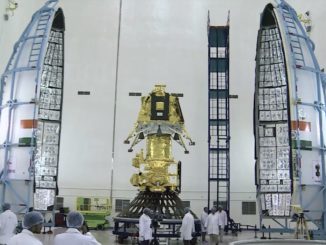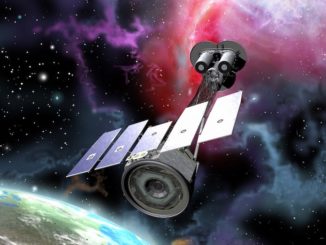EDITOR’S NOTE: Updated at 3 p.m. EDT (1900 GMT) on Oct. 9 with 24-hour launch delay.
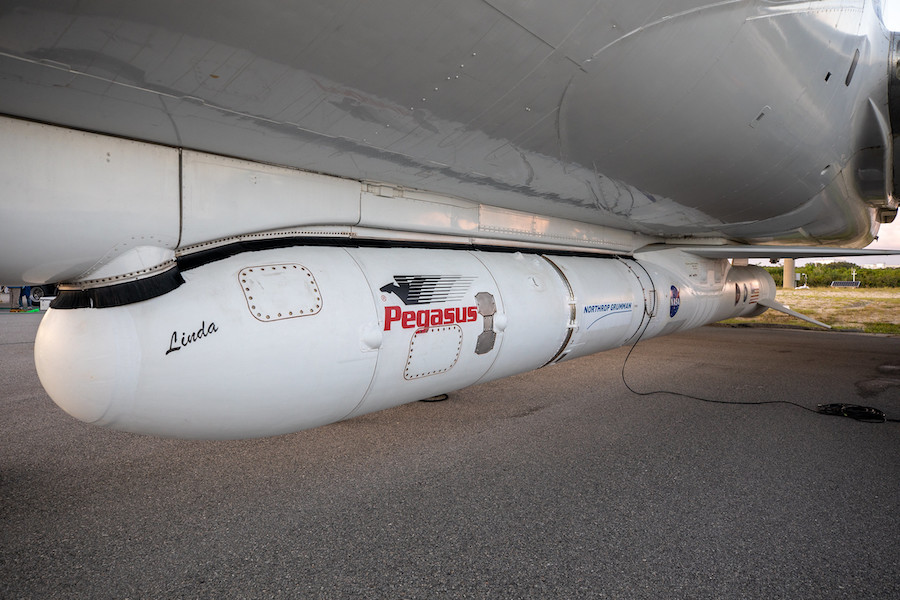
After a year-long delay to troubleshoot recurring erroneous data signatures from the rudder of Northrop Grumman’s air-launched Pegasus XL rocket, NASA is eager to send a $252 million research satellite into orbit as soon as Thursday night off Florida’s east coast on a mission to probe the ionosphere, a region near the boundary between Earth’s atmosphere and space.
The Ionospheric Connection Explorer, or ICON, mission is dedicated to studying the link between Earth’s weather systems and space weather driven by solar activity on the ionosphere, a layer in the upper atmosphere where plasma variations can impact satellite communications and GPS navigation signals.
“The ionosphere is continually changing, and it’s very dynamic, so that can have big impacts on our ability to do this kind of communication,” said Nicky Fox, head of NASA’s heliophysics division. “So not only is it a great place to go and study plasma physics, but it’s also a region that has a big space weather impact on us.”
Northrop Grumman’s L-1011 carrier jet will take off at 8:32 p.m. EDT Thursday (0032 GMT Friday) from the Skid Strip airfield at Cape Canaveral Air Force Station and head for a drop box roughly 50 to 100 miles (80 to 160 kilometers) east of Daytona Beach.
If all goes according to plan, L-1011 flight crew will release the 57-foot-long (17-meter) Pegasus XL rocket at 9:30 p.m. EDT (0130 GMT). Five seconds later, the three-stage Pegasus launcher will ignite and fire into orbit with the ICON spacecraft.
Launch managers delayed the Pegasus launch 24 hours from Wednesday due to poor weather conditions expected in the drop box over the Atlantic Ocean. Improved weather is forecast Thursday, when there’s a 70 percent chance of acceptable conditions for launch.
There is a 90-minute launch window available Thursday that opens at 9:25 p.m. EDT (0125 GMT Friday), enough time for the L-1011 carrier jet to make a second pass through the drop box if needed.
The drop box is located far enough offshore to likely prevent any launch viewing from locations on Florida east coast.
It has been a rocky start in getting ICON into space.
Two launch campaigns last year were cut short by erroneous data signatures that showed movement on the Pegasus rocket’s rudder, one of three aerodynamic control surfaces on the solid-fueled rocket’s winged first stage.
“It was the rudder actuator (where) we were seeing some anomalous position feedback readings, basically noise spikes in the feedback line,” said Phil Joyce, vice president of space launch programs at Northrop Grumman. We didn’t understand those, but they were significant enough that we were concerned that, if we launched with that condition present, those noise spikes could couple into our control system and cause a bad day.”
Engineers from Northrop Grumman and NASA spent 11 months analyzing the problem, testing hardware, developing corrective actions, and then preparing the Pegasus XL rocket and the ICON satellite for another try at launching.
“We wanted to get things right on this rocket,” said Omar Baez, NASA’s launch director for the ICON mission. “We have no second chances on these types of missions, and we want to get it right.”
Teams first noticed the rudder readings during a ferry flight last June to the mission’s original launch base on Kwajalein Atoll in the Pacific Ocean. Managers decided to return the rocket to Vandenberg Air Force Base — home to the Pegasus launch processing team — during a planned stopover in Hawaii.
NASA and Northrop Grumman officials agreed to relocate the mission’s staging base to Cape Canaveral in the aftermath of the aborted Kwajalein launch campaign. Launching from Florida was not originally planned because the ICON satellite was expected to be slightly heavier than it turned out to be, which would have required a launch from a location closer to the equator.
But similar rudder data readings cropped up during a ferry flight from Vandenberg to Cape Canaveral last October, prompting more data reviews and hardware changes in an attempt to resolve the problem. Teams thought they might have the issue fixed, but telemetry data again showed a potential problem after the L-1011 and Pegasus departed Cape Canaveral toward the drop box for a launch attempt Nov. 7.
Managers ordered another stand-down to further investigate the problem, and the L-1011 and Pegasus returned to Vandenberg.
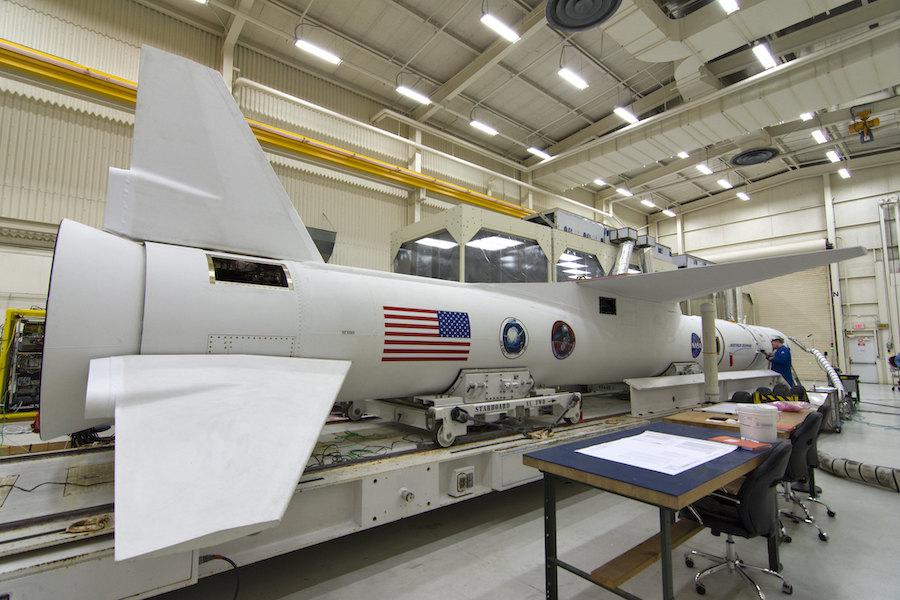
“It really says something about a team when you have a lot of adversity, and ICON is certainly no different,” Joyce said Tuesday. “This is an incredibly complex machine. We saw some things on our previous launch attempt that none of us were comfortable with, and we decided to stand down, go address those and make sure that we really understood what was happening there.
Engineers did not see the spurious rudder data during pre-launch testing on the ground. The problem only manifested itself when the Pegasus was airborne under the L-1011 carrier jet at low pressures and cold temperatures.
“That required a really extensive ground test, modeling, simulation and flight test activity to get the bottom of what was really an extremely challenging problem, one of the most challenging that I’ve seen in my career in this business over some 30 years,” Joyce said.
“But we got there,” he said. “With NASA, we were able to get to some surprising results that told us a little bit more about the system that we have on the Pegasus, and educated us, and we made some really smart corrective actions.”
Engineers were unable to identify the root cause of the erroneous rudder position data. The Pegasus launcher set to deliver ICON into orbit is the first to fly with a new actuator control unit. Joyce said engineers, among there things, made some “slight modifications” to electronics controlling the rudder actuators on the Pegasus first stage.
“There were actually five or six different things that we thought were coupling into this phenomenon that we were seeing, and what we did to correct the problem is we went and attacked all of those,” Joyce said. “So we modified our electronics to be less sensitive to this, we modified some of the hardware in that feedback circuit to be more robust to the environment that the L-1011 provides … And we went back and demonstrated that the modified systems would handle those environments in the lab, and then we conducted two test flights out at Vandenberg.”
On Oct. 1, the L-1011 ferried the Pegasus rocket back to Cape Canaveral. Engineers have not detected a recurrence of the rudder data issues in flight since last year.
Previous concerns related to ICON’s Pegasus rocket delayed the mission from 2017.
Engineers wanted more time to inspect the Pegasus rocket motors after they were mishandled during shipment to Vandenberg. That pushed the launch back from June to December 2017, the next availability in the military-run range at the mission’s original launch site at Kwajalein in the Marshall Islands.
Then managers decided to ground the mission to assess the reliability of bolt-cutters used to jettison the Pegasus rocket’s payload fairing and separate the satellite in orbit.
Those issues were closed out before the first ICON launch campaign last year, when the rudder problems first appeared.
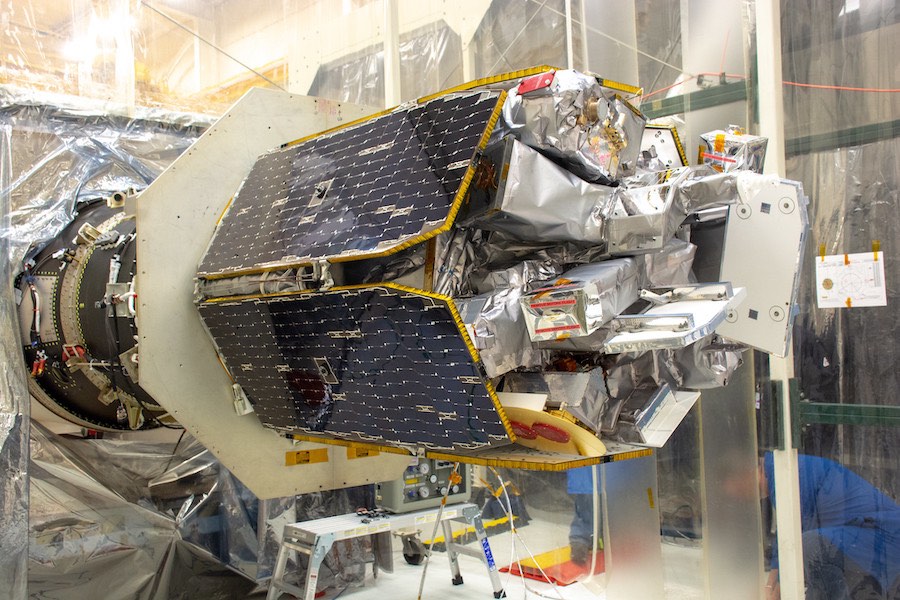
The ICON mission will be the 44th launch of a Pegasus rocket on a satellite delivery mission, and the 34th in the Pegasus XL configuration with uprated solid rocket motors. It will be the seventh Pegasus launch based out of Cape Canaveral, which hosted the most recent Pegasus rocket mission in December 2016.
The delays have not caused ICON’s total cost to rise above NASA’s $252 million budget for the mission, Fox said Tuesday.
Since arriving back on Florida’s Space Coast last week, the Pegasus launch team have put the rocket through a launch day dress rehearsal and completed most of the final closeouts on the vehicle.
Ground crews at the Skid Strip airfield will begin launch day preparations Thursday afternoon. The final hands-on tasks on the Pegasus rocket include the removal of safety pins from the launcher’s ordnance devices, and the installation of a door on the rocket’s payload shroud after checks of internal batteries.
The launch team will begin steps in the Pegasus pre-launch checklist shortly after 5 p.m. EDT (2100 GMT). After starting its engines, the L-1011 carrier aircraft will taxi to the Skid Strip runway for takeoff toward the planned drop point more than 100 miles east-northeast of Cape Canaveral.
The L-1011 carrier jet, a converted airliner previously owned by Air Canada, will head east, then turn around and fly west through the drop box to assess weather conditions. The “race track” pattern will culminate in a final turn to place the carrier aircraft on an easterly heading at an altitude of 39,000 feet (11,900 meters) and an airspeed of Mach 0.82, according to Don Walter, the L-1011’s command pilot.
A four-man flight crew and three Pegasus launch vehicle operators will be aboard the L-1011 during the ICON launch.
In the final minute before launch, the Pegasus rocket will sweep its fins to verify their readiness before Steve Gunn, Walter’s co-pilot, pushes a button to command release of the launch vehicle.
Hooks will open to allow the Pegasus to free fall for five seconds to a distance of several hundred feet below the L-1011, before the solid-fueled first stage motor fires to begin the climb into space.
“You lose 52,000 pounds (23,600 kilograms) all at once,” Walter said. “The airplane wants to go up. It’s kind of like a ride at Disneyland, which is a good thing for us. When that rocket lights off, we want to be a long way away.”
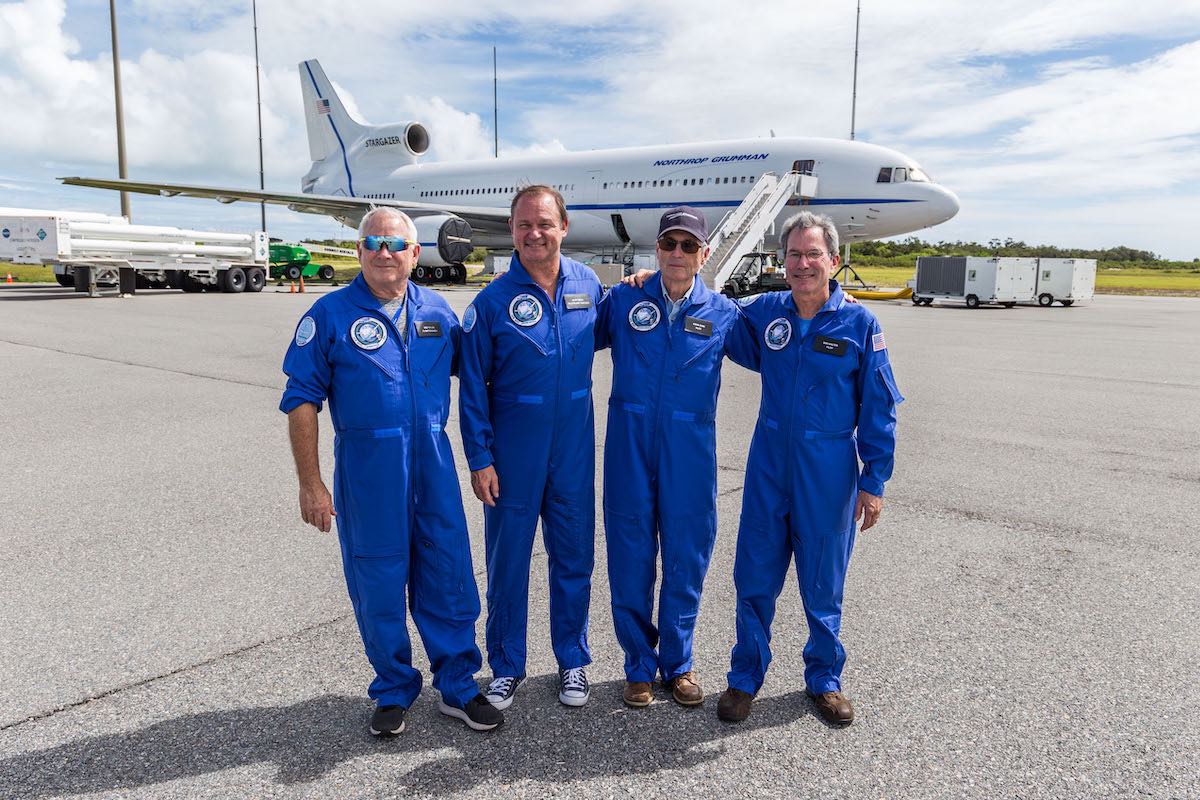
The Pegasus XL’s Orion 50S XL first stage motor will ignite and ramp up to 163,000 pounds of thrust, and the rocket will pitch upward to gain altitude in front of the carrier jet as Walter steers the aircraft awards from the launcher’s exhaust plume.
The first stage will burn out at T+plus 1 minute, 17 seconds, followed by stage separation around 16 seconds later. An Orion 50 XL motor will fire at an altitude of around 237,000 feet (72.1 kilometers) with around 44,000 pounds of thrust.
The Pegasus will be above the dense lower layers of the atmosphere by T+plus 2 minutes, 10 seconds, at which time the rocket will shed its clamshell-like nose cone to reveal the ICON satellite.
The Orion 50 XL second stage motor will consume all its solid fuel at T+plus 2 minutes, 48 seconds, then begin a four-minute coast phase for the rocket to climb to the targeted altitude for the ICON mission. During this time, the rocket’s on-board computer will calculate when it needs to ignite the third stage based on the performance of the booster to this point.
Separation of the second and third stages is planned around T+plus 7 minutes, followed seconds later by ignition of the third stage Orion 38 motor. The third stage’s 69-second burn will place ICON into a 357-mile-high (575-kilometer) orbit inclined 27 degrees to the equator.
The Pegasus rocket will release the 634-pound (288-kilogram) ICON spacecraft from its third stage at T+plus 11 minutes, 20 seconds. ICON will start extending its power-generating solar panels less than two minutes after deployment from the Pegasus rocket, then lock onto the sun to start charging its batteries.
ICON carries no rocket thrusters of its own, so an on-target deployment by the Pegasus rocket is critical to the mission’s success. After checkouts, ICON should begin scientific observations in late November, according to Thomas Immel, the mission’s principal investigator at the University of California, Berkeley.
Like the Pegasus rocket, the ICON satellite was built by Northrop Grumman. It’s based on the company’s LEOStar 2 satellite bus.
Wednesday is shaping up to be a busy day for Northrop Grumman. Two commercial satellites built by the aerospace contractor were set to launch aboard a Proton rocket early Wednesday, and ICON could be the third Northrop Grumman-made spacecraft to launch in less than 24 hours.
Technicians put the ICON satellite in climate-controlled storage while engineers investigated the Pegasus rocket’s rudder issues. Teams took ICON out of storage this summer to complete a full health check on the spacecraft. The testing included a deployment test of the satellite’s five-panel solar array wing to ensure the mechanisms needed to unfurl the panel were still fully functional.
NASA selected Immel’s proposal for the agency’s Explorer program in 2013 to probe the extreme variability of the ionosphere, ever-changing layer in the upper atmosphere that affects long-distance radio communications and GPS navigation.
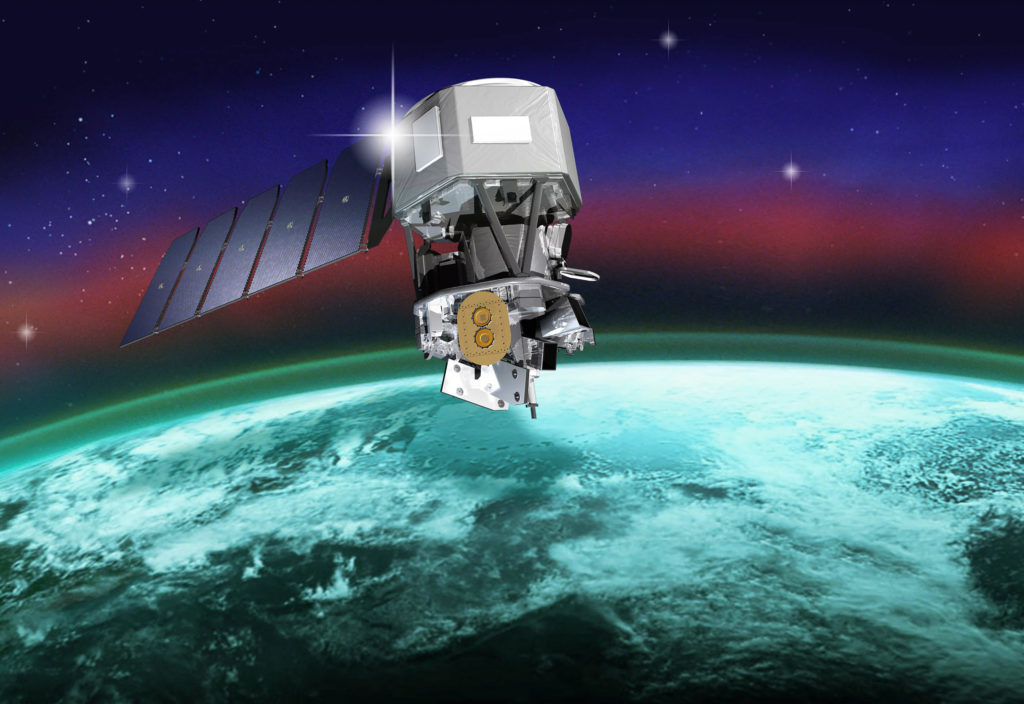
The ICON mission will investigate the link between conditions in the ionosphere, which scientists long thought was primarily driven by solar activity, and weather deeper in Earth’s atmosphere.
“The ionosphere is the densest plasma in space between us and the sun, and that plasma has a number of effects on systems that we use every day,” Immel said.
The ICON mission will study “how weather in our lower atmosphere, the weather we experience from day to day, influences conditions in space,” he said. “This coupling of the lower atmosphere to the upper atmosphere is a new science topic for NASA.”
Previous satellite missions detected the unexpected coupling between plasma waves and winds in the ionosphere and terrestrial weather systems.
“What we discovered, using data from a NASA mission called IMAGE, was that this region of the upper atmosphere and ionosphere was actually responding to effects related to weather systems near Earth’s surface,” said Scott England, ICON project scientist based at Virginia Tech. “This was really unexpected at the time, to see a connection. Where the charged particles were, how many there were, how dense the gas was — they were responding to weather patterns near the surface of the Earth.”
“We saw with those missions that the density in the ionosphere varied in response to changes in the rainy seasons in the tropics,” Immel said. “The new mission of ICON is to focus on that topic, and we’re carrying the instruments to invesitgate that region.
“We think focusing on that will give us a real key to understanding and making better predictions for space weather,” he said.
ICON carries four types of instruments developed at the University of California, Berkeley, the Naval Research Laboratory, and the University of Texas at Dallas.
Another NASA mission named GOLD — short for Global-scale Observations of the Limb and Disk — has objectives that intersect with ICON’s planned observations.
GOLD is mounted on a geostationary satellite more than 22,000 miles (nearly 36,000 kilometers) over the equator, providing wide-area views of the airglow in the ionosphere.
“ICON is going to come along and provide those in situ measurements, flying right through some of those plasma bubbles that we’ve been imaging with GOLD for a year now,” Fox said.
If ICON had launched on its original schedule, it would have been in space before GOLD.
“There has been a two-year delay,” Fox said. “We have learned a little bit more science. We now have a year’s worth of GOLD images, so I think, if anything, we’re even more excited about what ICON is going to bring to us.”
Email the author.
Follow Stephen Clark on Twitter: @StephenClark1.

